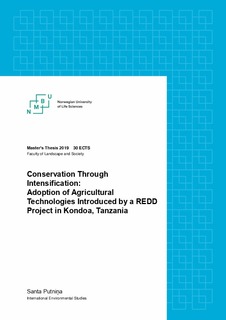| dc.description.abstract | One of nine REDD pilot projects was implemented in Kondoa District. This pilot project had been managed by the African Wildlife Foundation (AWF) from 2010 to 2014. The aim of the project was to achieve strict forest conservation in the Kondoa-Irangi Hills. The main compensation for enclosure of the forest was the implementation of an agricultural component named ‘conservation agriculture’. This meant that 12 demonstration farmers in each of the 19 participating villages received support in the form of improved seeds, pesticides and fertilizers as well as advise to plant in straight lines. The actors behind the REDD project have especially highlighted the agricultural component when arguing for the project’s success.
This thesis evaluates the implementation and impact of the agricultural component of the REDD project in the Kondoa District. The case study was conducted in two out of the 19 participating villages - Mnenia and Bereko. For comparative purposes, a parallel survey was carried out in the two villages that decided not to participate in the REDD project (Itololo and Kisese Disa). It is assumed that data from both villages that did and did not participate in the project will display differences between the sites and, therefore, will allow to estimate the project impact. To assess the research questions, a mixed method research is applied. This involves gathering and integrating both quantitative and qualitative data. The primary data were collected in October and November 2018 using interviews and household questionnaires.
First, it is concluded that the label ‘conservation agriculture’ given to the agricultural component is misleading. The three principles of FAO's defined version of CA (permanent soil cover, minimum soil disturbance, crop diversification) was never promoted. While the agricultural component of the REDD project has been presented as a particular success, I find little evidence that the agricultural component had a significant effect on rural livelihoods and state of agriculture in Kondoa district. Generally, the results show modest adoption rates of practices promoted by the REDD project. The rate of agro-chemical use in Mnenia is the same as in villages that did not participated in the REDD project (with 6 % of farmers using synthetic fertilizers and 18 % using pesticides). Agro-chemical use in Bereko is higher than in control villages, however, it is hard to draw an adequate conclusion if REDD had any effect on it or it is the characteristics of Bereko village itself (mainly location) that facilitates high adoption rates. The REDD project’s agricultural component relies on investments into expensive inputs and, perhaps not surprisingly, the author finds wealth and asset ownership to be strongly correlated with the use of farming inputs. | nb_NO |

